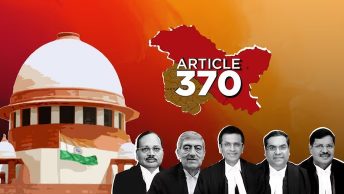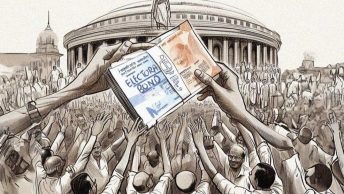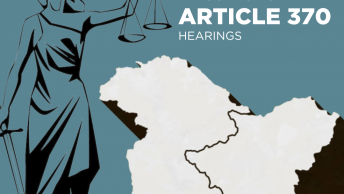The Everyday
In Sedition in Liberal Democracies, Dr. Singh “juxtaposes the understanding of sedition emerging from the higher judiciary with the practice of the law on the ground.” Her chosen field sites were Haryana, Maharashtra, and Punjab, where she interviewed people accused of sedition, station house officers, and members of communities on either side of a sedition case that was triggered, often, because of underlying tensions around caste and class.
Her research into the use of sedition in Ismailpur, Haryana is illustrative. (Page 245, Sedition in Liberal Democracies). In this case, Dalits in Ismailpur began resisting a common practice of Gujjar men to ‘claim’ Dalit women as their own, and then abandon them at whim. The family of one such girl resisted the attempt of the local Gujjar leader to forcibly take her away and arranged for her to be married. A violent conflict ensued between the Gujjars and the Dalits, post which the Arms Act was applied against both groups, however, sedition was added to the case against the Dalits. A sub-divisional magistrate reflected on this difference by claiming that ‘Gujjar’s were criminals’ and therefore the Arms Act was par for course, however ‘the Dalits had a political motive’. It is clear however, that the contours of this case run afoul of legislative or judicial imagination of sedition–that of a violent overthrow of the government. Further, the presence or absence of sedition in the FIRs is a decision explicitly grounded in one’s caste. Singh further writes of the 2012 Bhagana sedition case in Haryana– a case filed against Dalits over a peaceful protest against the Chief Minister of Haryana. The primary accused in this case revealed in an interview that the Station House Officer was being given instructions over the phone on what to write in the FIR. (page 259, Sedition in Liberal Democracies).
This phenomenon was also reported by A Decade of Darkness in a case in Uttar Pradesh in 2021 against Samajwadi Party workers. The Uttar Pradesh police arrested these workers for sloganeering and burning an effigy of chief minister Yogi Adityanath. The men faced charges of rioting and obstructing traffic. However, the police later applied Section 124 A of the IPC to the FIR. The Chitrakoot District President of the SP said “anyone can guess what might have happened. While the entire FIR was typed, section 124 A was written by hand.” This prevented easy bail for the men, among whom were a few aspirants to the upcoming Zila Panchayat polls.
In another illustration of everydayness where no expressions of protest were present, a physical altercation quickly turned into a sedition case in a pub in Bengaluru city on the night of 22 February 2019 (this was only three days after the Pulwama attacks). A food delivery man directed some comments towards a group of female students. An argument ensued, followed by a fist fight that had to be dispersed by the police. At the police station, each group filed a case against the other. Based on the students’ complaint, a case of assault, illegal assembly and wrongful restraint was filed against five or six delivery men. In their counter complaint, however, the men said the students had shouted ‘Pakistan Zindabad’ and anti-government slogans, and therefore sedition charges were invoked.
Further, in 2017, the year when Pakistan won against India in the finals of the ICC Champions Trophy, that last match coincided with the festivities of Ramzan. The son of a popular Panchayat member in a village in Karnataka was accused of bursting fire-crackers after Pakistan’s victory. According to him, his friends and he were passing the late-night hours by bursting firecrackers to shoo away elephants that occasionally come to the fields. “In fact,” he said, “if we had to celebrate anything, it was India’s victory over Pakistan in the hockey match on that day.” Fifteen minutes after he and three friends burst firecrackers, they were arrested, on a local BJP leader’s complaint. At the police station, a crowd of BJP workers gathered, demanding action. The accused also revealed that the case stemmed out of political rivalry between his father and the complainant.
Clearly, the use of sedition takes on ‘discursive formations’ through its interpretations inside and outside the courtroom, as Singh describes in her penultimate chapter (Page 361).
That is, its form mutates depending on the government in power, religion, geography, caste, class, and even occupations– a combination of these variables determines executive mandates to register FIRs. The juridical understanding of sedition, as Singh writes, starkly conflicts with the executives.
This is particularly evident in the way Section 124A is used in police stations. Interviews in police stations in Kurukshetra, Haryana, revealed that “almost none of the local police actually knew what the offence of sedition was and what constitutes Section 124A of the IPC.” (page 262, Sedition in Liberal Democracies).
What does the future hold?
Since 2014, the rise of the Hindu nationalist complainant-ideologue should worry the judiciary. The conflation of religion with state has energised them to file or pressure the police to file sedition cases. As Sanjiv Ray, a truck driver in Assam and a member of the Rashtriya Swayamsevak Sangh said about a case he filed against a young Muslim boy who posted a photo of himself with the Pakistan flag, “I registered the complaint out of love for my country. Living in India, how can he support Pakistan?”
Narasingh Pandey, the District Vice President associated with the Hindu Yuva Vahini, dictated the charges to be added in the FIR (including sedition), in a Maharajganj police station. He was offended that Feroz Ahmed, an electrician, allegedly insulted Yogi Adityanath, the Chief Minister of UP on social media. According to Pandey, “One of my duties as a leader of the Hindu Yuva Vahini is to file complaints with the police against those who speak or write against our gods and goddesses or our Maharaj-ji (the honorific commonly used to refer to Adityanath) or any other Hindu religious guru.”
In a review of Singh’s book, Arudra Burra calls this the ‘affective conception of sedition’, where “seditious speech involves creating ‘bad feelings’ against the state or nation. This conception of sedition is at work when it is claimed that so-called ‘anti-national’ speech should be punished as seditious, even when there is no connection with public violence.”
Burra goes on to say that these kinds of accusations made by private parties would not be enough to sustain convictions, owing to the lack of evidence linking the ‘seditious’ speech to violence. But, he says, “in many cases, presumably the threats will do their job: that of stifing political dissent in service of right-wing ideologies, or more insidiously in the long run, that of changing the character of public discourse in India.”
He is right, and the proof is in the examples set by Hindu nationalists like Ray and Pandey.
Yet, on 7 May 2022, the solicitor general, in his written submissions before the Supreme Court hearing the petitions challenging sedition, urged that Section 124A not be reconsidered and further that individual instances of misuse are not a ground to invalidate the provision.
The case studies above illustrate that the trigger for filing FIRs involving sedition will continue to be dictated by socio-political considerations. In this context, therefore, to “fetishize” the laying of guidelines to regulate the use of sedition is wholly out of touch with the fundamental premise of Section 124A.
In Reflections on the Anthropology of Law, Governance and Sovereignty, John L Comaroff & Jean Comaroff in discussing the global rise of cultures of legality, speak of this fetishism by saying that “an abstraction – in this case, ‘the law’ – is objectified, ascribed a life-force of its own, and attributed the mythic capacity to configure a world of relations in its own image.”
We needn’t look too far to find the myth of the law. At a protest site in Haryana, Singh spoke to a CID inspector present who said, “mukaddme to jo sarkar chahti hai wahi lag jate hain, iske liye IPC dekhne ki zaroorat nai padti. (The legal charges are but a fancy of the government, you don’t need to see IPC sections to slap cases.)”
Conclusion
To return to the courtroom, what is interesting about the interim order dated 11 May 2022, is the appearance of colonial baggage as a reason to move on from sedition– a line that the Court borrowed from the Union Government’s affidavit invoking ‘Azadi ka Amrit Mahotsav’ (75 years of India’s independence) as a normative consideration to review the law.
Burra, in a somewhat chilling and prescient retelling of the present and the future, says, “a right-wing government keen to acquire the powers to suppress speech which it considers anti-national has a simple expedient. Abolish Section 124-A because of its colonial origins, then re-enact a new law aimed especially at ‘anti-national’ speech. Justify this in the name of democracy.”
Therefore, it is critical that even if the court strikes down this law, to do so only on normative grounds that we are shedding colonial baggage would be misleading. The court needs to pay attention to the volatility of today’s hyper-local and national politics as triggering the registration of FIRs in wilful ignorance of judicial decisions.
Yet, despite all legal and constitutional evidence to demonstrate the illegalities of sedition, in its order ‘hoping and expecting’ that the government would not file FIRs, the Supreme Court may well have left us in a, to borrow an Ali Sethi expression, pasoori (state of confusion).
Lubhyathi Rangarajan is Editor-Databases at Article-14. Acknowledgements are due to Dhirendra Jha, Mohit Rao and Makepeace Sithou for investigative reportage from Uttar Pradesh, Karnataka and Assam, for A Decade of Darkness. Parts of this article have been reproduced with permission from an article originally published for Article-14 on 12 May 2022.
Disclosure: Dr. Anushka Singh was an Advisor to A Decade of Darkness.
[Editor’s Note: This article is edited by Shravani Shendye and published by Avani Vijay from the student editorial team. Part I is available here]






[…] Posted byLubhyathi Rangarajan […]
very informative articles or reviews at this time.
Download 1WIN APK and enjoy live cricket betting, slots, Teen Patti, and Aviator in one powerful app.